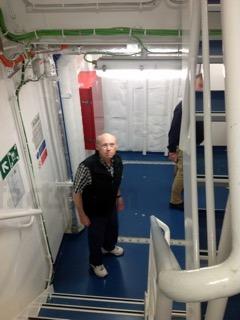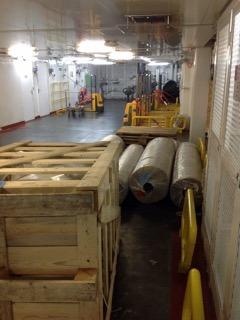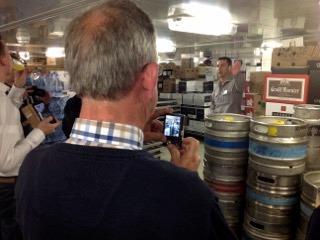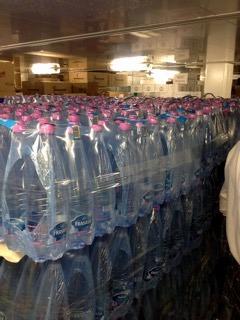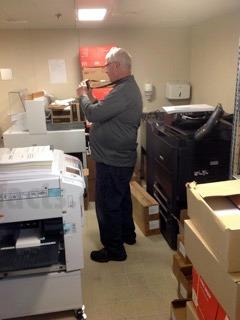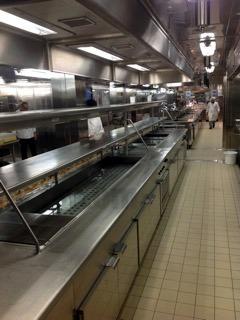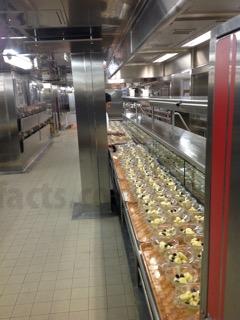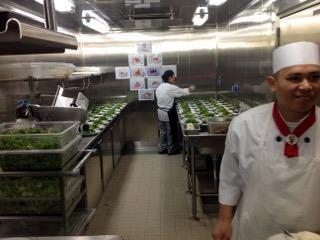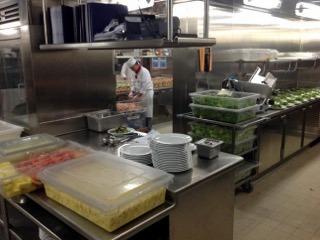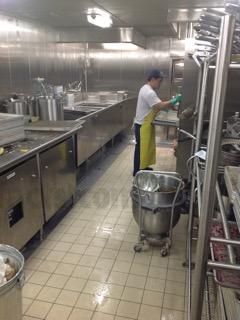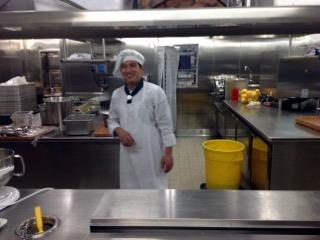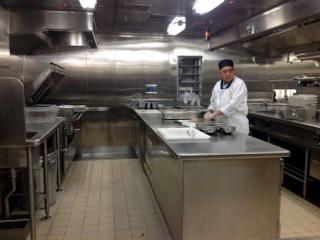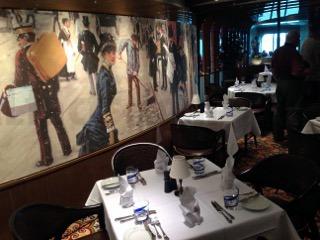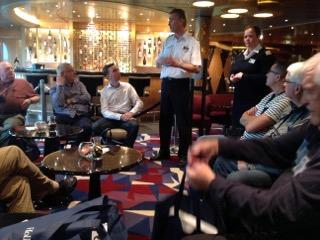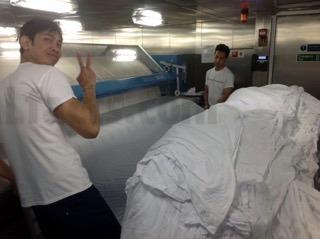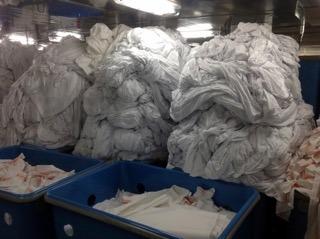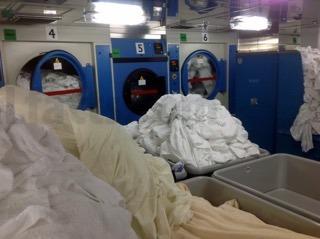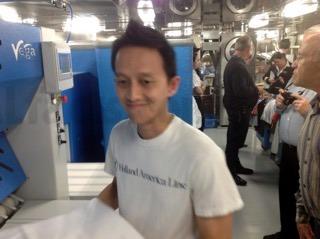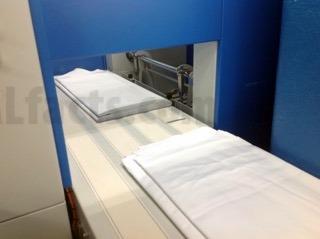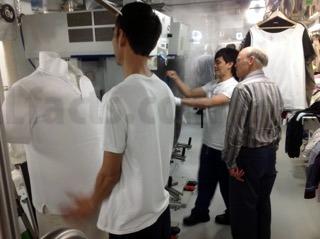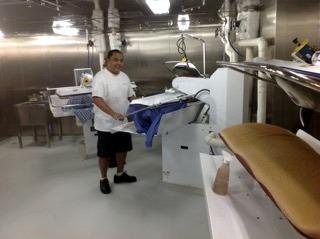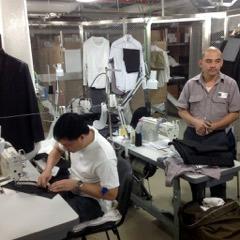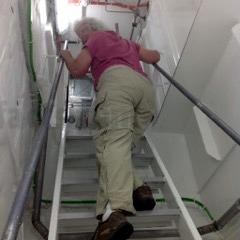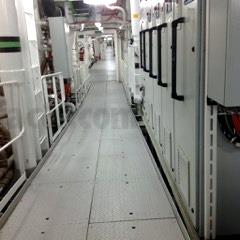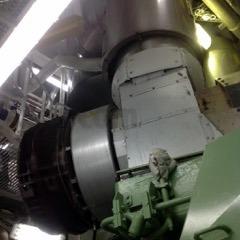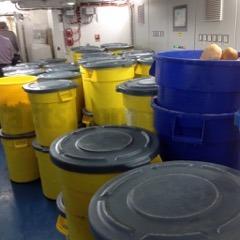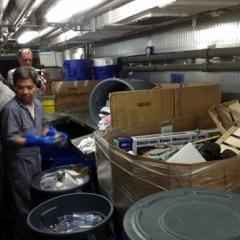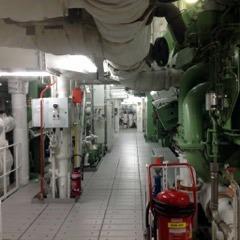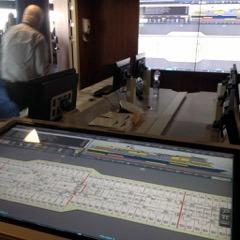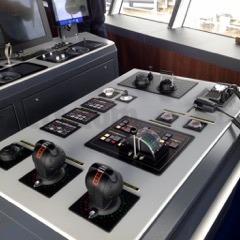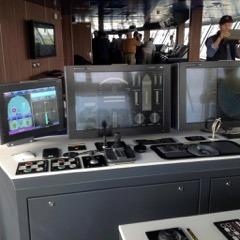Thoughtfully provided by Susan McClung. Tour and photos taken in July 2016.
It is true that Koningsdam is not your typical Holland America ship, but we really looked forward to our behind the scenes tour. It is also true that the tour was $150.00 each but we did it anyway. There were 18 people (3 more than usual), including Jerry and I on the tour. Here is another number for you: 15 of the 18 people were male. Yep, yours truly was one of 3 women on the tour.
Part 1 of the tour was on the Helsinki day, and originally part 2 was going to be the next day, a sea day. As it happens, part two took place on our Gothenburg, Sweden day.
Some things to note: At each stop, we got explanations, and questions answered from the appropriate person. This tour is not for mobility-challenged people. There are some steep stairs involved, some steeper than these Jerry is on. The tour was totally worth it, to us. We were welcome to take pictures anywhere, and not have to ask permission.
Astrid began the tour with explaining how passengers, but mainly fellow crew and staff members can tell at a glance which department a person is in. For example, red means medical department, green means recycling, blue means engineering, and white means hotel department. Astrid said some people in other departments joke about toilet paper because of the white. She also explained about the single colorful buttons with no function other than to be a fashion statement.
The tour included:
- a visit to the dressing room of the World Stage. Our tour guide, Astrid did some explanations, and sort of did an interview with one of the singers, and one of the dancers. This first group of dancers had trained for a year for this ship and the new production shows on the World Stage which is drastically different than anything else at sea. The singers had trained 6 months. The next lot will have trained 8 weeks. The next lot of dancers will be the same or similar in size because they will be using the same costumes. They explained about costumes and costume changes (some as fast as 7 seconds), having one of the people in charge of seamstress duties, how they modify performances during rough seas and wear flat shoes instead of high heels, “sick tracks,” and much more.
- a visit to the marshaling area where everything comes onto the ship, and leaves it. This means luggage, food, supplies – everything.
- a visit to the equipment area to bring stuff on and off. They use pallet jacks rather than fork lifts.
- a visit to the beverage storage area. We had never seen so much water, booze, and juice together in one place before. Before entering, we were offered our choice of mimosas or orange juice.
- a visit to the egg and dairy storage area. (no other food storage areas seen) It is clearly a BIG job to order all the food, for passengers and crew, especially since this is a new ship there is not much history to go on for the ship, nor for the itineraries.
- a visit to what I will call the safety area with extremely detailed ship diagrams.
- a visit to the very small but obviously effective print shop where they produce things like menus and planners.
- walking through corridors that were carpeted, or painted metal, or unpainted metal. We learned why many areas are not carpeted – too much wear and scratching.
- a walked through plainly carpeted corridors of crew quarters though we did not go in any of the rooms for obvious reasons. The number of occupants is shown above each door. 2 people share most rooms, with adjoining bathrooms for every four people. Senior staff will have a room to themselves. We also learned about contracts.
- a visit to the main kitchen, and to the kitchen for the Sel de Mer Restaurant.
- in the main kitchen we learned such things as the cooks have pictures of that days dishes so every plate looks consistently great.
- a walk through of the Sel de Mer Restaurant.
Last stop was being seated in the Ocean Bar to have both Astrid and Stan the Hotel Director talk to us. They both told us more ship facts. Amongst other things, Stan was telling us something about the sea trials for this ship and others he had been on. On other ships, when they ran the engines at top speed, then turned the steering hard around, the tilt had gone to 27 degrees. The Koningsdam went to 6 degrees on the same test. One of our fellow Cruise Critic members later said that’s nothing, and is impressive. At the same time, attentive servers were offering us both alcoholic and non-alcoholic drinks and assorted finger food. Each person was given an Holland America cloth bag. Each held pretty much the same things. My bag had “A Taste of Excellence” main dishes cookbook. Jerry’s bag had an appetizers cookbook, which includes salads and much more. In each bag: a double-sided page of all kinds of ship facts, an 8.5 x 11 glossy photo of the ship.
This second part of the tour would be more physically demanding, Astrid made clear. There would be very steep, narrow steps. There would also be noise, so she issued everyone with earplugs to be ready. Everything was again fascinating. In each department a lead person explained how things worked. We toured the laundry where we learned how everyone’s laundry is kept straight, washed, ironed, etc. We saw a giant mangle in action as it took in moist sheets, ironed them, and folded them. There were very high piles of laundry. As you might imagine, it was pretty warm in this area. The week before, the machine had not been working. We also visited the ship’s tailor where when fully staffed has 4 people working to make the uniforms and other clothes for the crew. Obviously, it is a very large job.
We visited the area of the ship where they deal with garbage and recycling. As you might imagine, the ship has its own recycling center where crew wearing latex gloves picks through trash looking for recyclables, and sorts everything They even make a little money at it. We learned how what trash cannot be recycled is either burned, or ground into tiny bits and pumped out. Waste water is in a very real sense used to help power some things. Sewage is treated many different ways, and ultimately gets pumped out into the sea. The ship also has its own desalination plant.
We went ever deeper into the ship, well below the waterline going down really steep stairs. To give you an idea, it was easier for me to go down backwards. Perhaps I was the only one who did so. I don’t know. We saw all kinds dials, gauges, and of course engines. There are engines at both ends of the ship so if one fails, there are will still be power. They explained how the doors came down to seal areas if needed. I also noticed again as I did the first part of the tour that line arcs that show how wide and where the doors swing.
One of the things of interest in engineering, is how clean everything is kept.
We also got to see a passage that goes the entire length of the ship. Impressive, along with everything else we saw.
We visited the engine control room where for sure there were all kinds of blinking lights, gauges, monitor screens, LED screens, buttons, etc. Here, we were told we could take pictures as in all other areas, but we were not allowed to post them on Facebook. Somehow, I don’t think HAL would want them posted on the HALfacts site, either, so I am not including those pictures.
We visited the bridge where the 3rd Officers, a 23-year-old guy explained operations and techniques in both rooms of the bridge. He also explained signal flags which are still used as part of an old tradition. Someone asked if staff still need to know how to use a sextant. The answer is yes, but they are used perhaps once a year. Paper charts are not used at all anymore. Quite the place, for sure, again with all guides of displays, buttons, switches, lights, etc. There are what I will call standing stations, and impressive looking chairs, each with their own sets of lights and indicators. The views from here, of course, are very different than from the rest of the ship.
Finally, we got to meet Captain Rowland. He explained about navigating, (coming out of Gothenburg was his least favorite), how rotation of captains work, and much more. Then a ship’s photographer took a picture of each single or couple with the captain, then a group picture with the captain. Having a picture taken with the captain was the last event on day tour of our behind the scenes tour. The pictures, they explained, would be delivered later to our cabins.
I am so glad that Jerry and I went on the tour. It was great. We learned a lot, and saw a lot that most passengers will never see. They only give this tour once a voyage, ordinarily for 15 passengers as I mentioned before.
We told our new cruise friends Norm and Jo about it, and they decided to do the tour during this Norwegian cruise.

